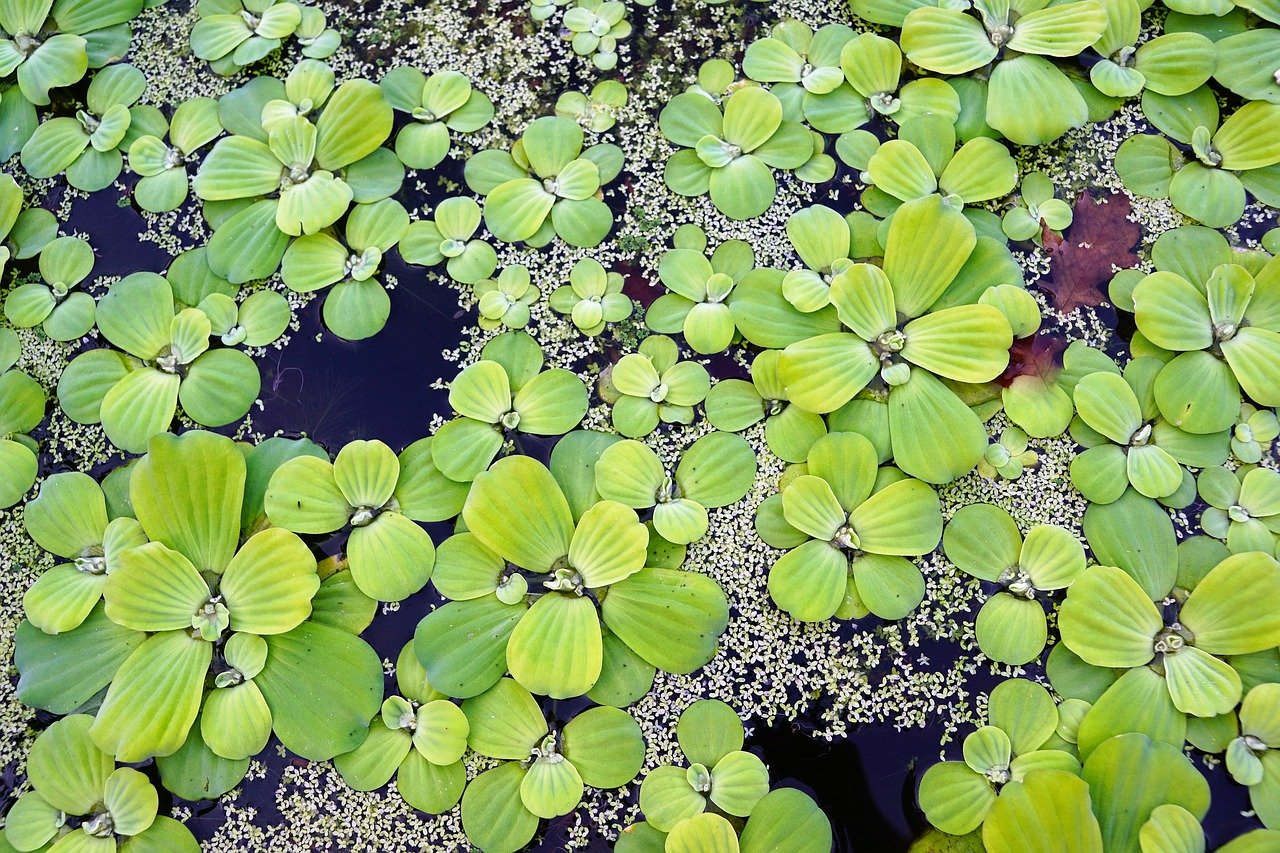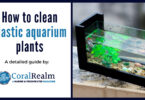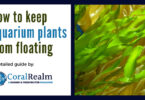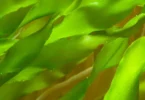Last Updated on February 10, 2023 by Matt
Dwarf Water Lettuce, Pistia stratiotes, is a fantastic floating aquarium plant option. Fast growing and easy to care for, this plant offers great value in any freshwater aquarium setup. Not only does it look fantastic and is something a little different, it also has a host of benefits that it will give to the tank.
In this Dwarf Water Lettuce care guide we will give you all the information that you need so that you can keep this plant successfully in your tank.
| Dwarf Water Lettuce Summary | |
| Family | Araceae |
| Care Level | Easy – moderate |
| Minimum tank size | 10 gallons |
| Temperature Range | 72°F – 86°F (22°C – 30°C) |
| pH | 6.5 – 7.5pH |
| Placement | Floating |
| Growth rate | Fast |
| Lighting | Low – medium |
IN THIS ARTICLE
Description
Dwarf water lettuce, scientifically known as Pistia stratiotes, is a common floating plant found in ponds and aquariums. This plant is double sided and has many benefits to an aquarium, including reducing algae bloom and creating shade. It is also known as water cabbage, due to its similarities with leafy green vegetables. The dwarf water lettuce is a popular plant amongst the aquatic community due to its reliability and pretty simple care, it also grows very quickly in the right conditions.
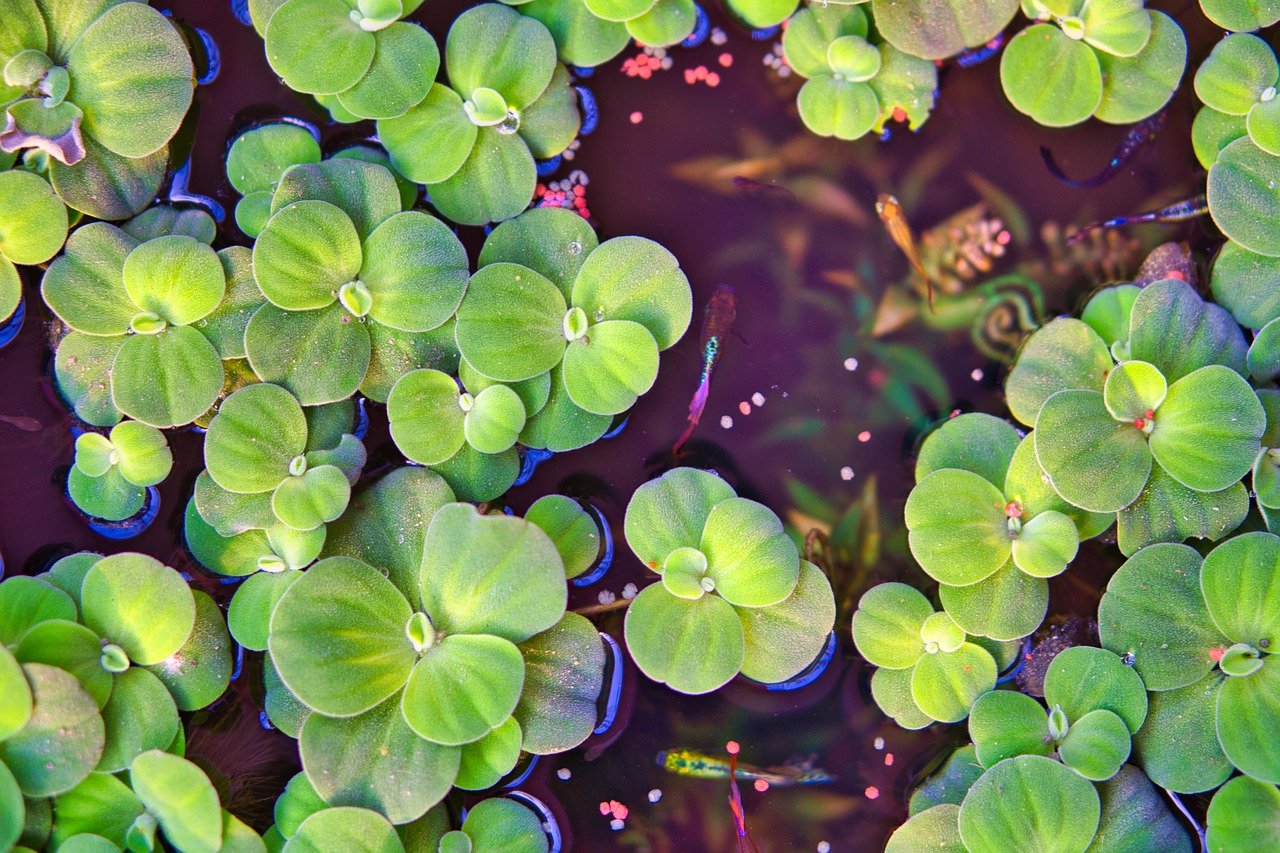
This plant is light green in color and has small rounded leaves that cover the water completely as it grows, it has white, green or blackish roots that hang below the leaves, these roots can grow further than a foot. Dwarf water lettuce can actually bloom, and the flowers get hidden in between the leaves. Unlike the usual water lettuce you can find which has large leaves, dwarf water lettuce only grows up to 1.5 – 2.5 cm, however once the plant is in the right conditions it will take over the surface of your water and grow at a fast pace, especially if there is no movement in the water form a fast flowing filter.
Dwarf water lettuce is native to Africa, and was discovered over 2000 years ago on the Nile River; it is known to have been around in the Ancient Greek era, found out through writings by famous botanists. This plant is sometimes referred to as Nile lettuce, which most likely came from its origin. Dwarf water lettuce can be found in various places including marshes and lakes.
Benefits of Dwarf Water Lettuce
Dwarf water lettuce is much more maintainable than regular water lettuce, even though it can still grow very quickly. Dwarf water lettuce will thrive in an environment with lower light, available nutrients and little to no water flow, this will allow the plant to spread quickly. These plants have several benefits, they shield your fish, control the conditions of your aquarium and create a healthier environment for themselves and other animals in the tank with them.
Shelter:
As dwarf water lettuce floats on the surface, once they start to grow and spread they start creating a shield like barrier, this is perfect for fish that need low light or shaded areas, as well as being beneficial for young fish and invertebrates that you may be breeding. This plant also has long roots that provide natural hiding spots for small animals, this is great for using all of the aquarium space, as shop bought hides are more beneficial for bottom dwelling fish. This plant creates a natural looking environment in an aquarium and will help any shy fish to explore and move around the tank, many fish hide away due to the lighting, so using this plant to create shade can help this.
Controlling aquarium conditions:
Dwarf water lettuce thrives on nutrients, and helps to keep algae under control as it takes away its food source. Phosphate is an important fertilizer, and if levels get too high in an aquarium algae can bloom. Phosphate removers can help if this occurs, but plants have this effect naturally, removing nutrients from the water column.
This plant also reduces the nitrate and ammonia levels in their environment, as it uses these compounds as a source of nitrogen. This is perfect for fish owners as a rise can be harmful for both fish and most aquatic plants; whereas dwarf water lettuce absorbs these substances. Ammonia poisoning can occur even at low concentrations and is deadly. Whereas nitrate poisoning only occurs at very high levels of nitrate, but is no less deadly. This plant also helps the growth of beneficial bacteria, which improves the water conditions of its environment and creates healthy conditions for the animals around it.
However, this can become a negative issue if the plant spreads too far for the size of the tank and it can strip too much of the nutrients away. There are many species of fish and invertebrates that thrive on algae. So a high number of water lettuce can be an issue for these species. However this can always be supplemented with algae wafers to give to the fish.
Dwarf Water Lettuce Tank Requirements
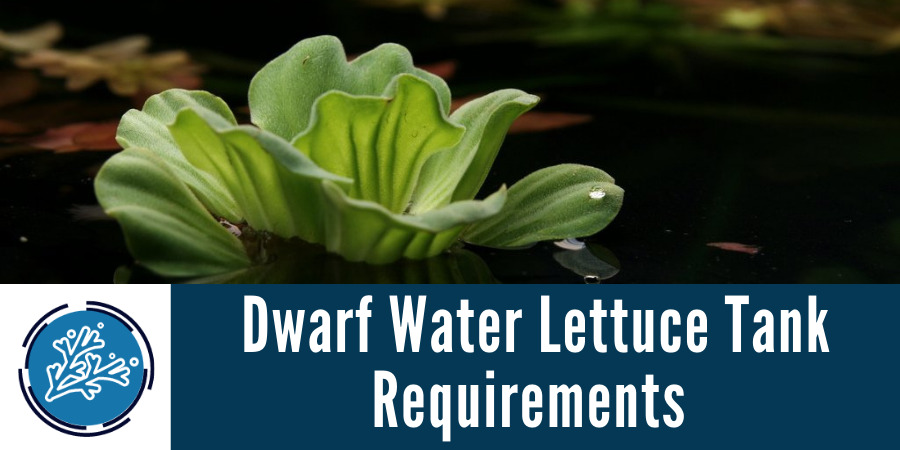
Tank size
The minimum size you want to grow dwarf water lettuce is a 10 gallon tank, as they multiply so quickly. A smaller tank also means that the surface of the water will get completely covered in the plant and some of it will need removing to prevent suffocation of the other species and to keep the plant under control; this will have to happen much more regularly in a small tank and it can become an unwanted inconvenience. As their roots can grow pretty long, a small tank will also get completely invaded by this plant. This won’t leave any space for any fish or other animals that you house with it. A bigger tank will accommodate for this growth. Which will allow you to maintain the plant and keep the other species happy.
Dwarf water lettuce also thrives in a high humidity environment, so a tank with a lid is usually the best option, especially if the room where the tank is situated is at a low humidity level.
Water parameters
Dwarf water lettuce is a tropical aquatic plant, so it thrives much better in warmer water, we recommend housing this plant between 72°F to 86°F (22°C to 30°C), it will survive in slightly cooler temperatures of 64°F (18°C) and above and will grow at a slower rate, however it certainly will not thrive at this temperature.
This plant is hardy when it comes to the pH range and can live in a pretty wide range, however the preferred level is around neutral of 6.5 to 7.5.
Lighting
Dwarf water lettuce thrives well in medium light, they are usually grown and sold in a shaded area so when introducing this plant to your aquarium it is best to slowly introduce the light. Placing them directly under bright light for the first time can result in the leaves becoming scorched and broken, if you notice your dwarf lettuce leaves are becoming brown around the edges even if they have been in the tank for a long time, this may be an indication that the lighting is too bright or too physically close the surface of the water. LED lighting which cannot be dimmed may be too bright for this plant.
This plant grows best under a full range set of T5 or T8 full-spectrum small bulbs, here are some of our recommended lights for dwarf water lettuce:
Water flow
Dwarf water lettuce tends to prefer a slow water flow, this also lets them grow much more quickly. The water flow will determine how big this plant grows, the slower the water flow the bigger this plant will grow as it is not being constantly pushed around the water. This plant is not used to strong currents in the wild, and therefore will not be used to a strong filtration in an aquarium, a gentle water flow will help keep the plant under control as if it is left in completely still water it will grow at a rapid rate and can become hard to maintain; a gentle flow will also prevent any harm coming to the plant.
You can keep this plant in fast flowing water, but make sure to acclimatize this plant beforehand, making sure to raise the water flow in stages if this is possible. A sudden change in environment from a gentle to high water flow can potentially damage the plant and prevent it from growing. Keep in mind that having this plant in a tank with strong filtration and water flow will prevent it from growing into a large plant, and will keep the plant and its leaves very small; this is sometimes preferred for aquatic plant owners who have smaller aquariums.
Dwarf Water Lettuce Care and Maintenance
Dwarf water lettuce is a great plant to maintain, as it floats on the water’s surface you can simply pick up a handful when it gets too overcrowded, and put it in your compost or anywhere that is accessible to you. This way you don’t have to worry about removing a plant that has long roots growing in the substrate, and removing these can be a tricky situation and can end up ruining the roots of other plants growing near it.
This plant connects to each other as it grows through small, thin connectors known as runners. If you wish to remove a part of the plant to another aquarium or just to simply get rid of, you can detach the runner and move the plant; this does not affect the plant in any way and it will grow back over time as normal. Removing this plant depends on the other animal and plant species being housed with this plant. While the size of tank could be perfect for a betta tank, betta fish are labyrinth breathers that need constant access to the surface of the water, if the dwarf water lettuce is rapidly growing and overcrowding the surface, it can be very dangerous for a betta, as well as any bottom growing plants you may have that need access to the light source in order to thrive. For a list of appropriate plants for betta fish read our guide on that subject.
For general care and maintenance, you can remove some of the leaves that look old or unwell, usually ones that look brown or white in color; this will help to maintain the growth and keep the plant healthy.
For root growth, it is best to keep this plant away from hungry herbivores that will constantly munch on the roots of the dwarf water lettuce, this plant gets most of the nutrients through its roots and constant interference with the roots can cause damage. You can also trim the roots occasionally to prevent them from getting caught in the substrate and in any decorations once they grow too long, make sure to only trim a small piece off the roots and always leave at least 4 inches of root left.
Using a liquid plant fertilizer will ensure that the plant has enough nutrients, as dwarf water lettuce is a column-feeding, drawing nutrients directly from the water column.
Make sure your water is always at the correct temperature of 72°F – 86°F (22°C – 30°C), this can be monitored using a good thermometer; see our article on the best aquarium thermometers to find the one most suited to your aquarium. Having a thermometer will let you know if your heater is working correctly, make sure the water never gets below 64°F (18°C); cold water can be fatal to this plant.
This is a floating plant where the roots are submerged and the leaves are exposed to the air, it is important to keep the leaves dry. The leaves of a dwarf water lettuce actually have a hydrophobic coating that acts as a water resistant barrier for things like water droplets that will slide off of the leaves and keep them dry.
If the tank you are housing this plant in has a lid, which is recommended to keep the humidity up, it can sometimes form condensation on the inside of the lid if the lid is tightly secured, this can be a problem for the dwarf water lettuce as a constant flow of dripping water droplets falling onto the leaves prevents them from staying dry. It is best to either keep the lid slightly open to prevent condensation, or to remove the lid completely but regularly monitor the humidity levels to make sure they are staying high. If you wish to keep this plant in an open top tank, make sure the tank is in a room that is not low in moisture.
Adding Dwarf Water Lettuce to an Aquarium
Firstly, make sure you are sourcing dwarf water lettuce from a reliable breeder or aquatic store to ensure the plant is healthy. It can take a few days for a dwarf water lettuce plant to acclimatize to its new environment, make sure that any other species in the aquarium is compatible with this plant, ensuring that there are no large root eating herbivores that will ruin this plant’s roots and prevent their growth.
It is best to quarantine this plant before adding it to the aquarium to remove any small invertebrates or parasites that may be hiding between the leaves that can damage your aquarium’s water or species; even small predators such as nymphs or damselfly can be on the plant. This commonly occurs with aquatic plants that have been ordered online, allowing the plant to sit in a small tank of water will let any unwanted substances be removed before putting it into your established aquarium set up.
Growing Dwarf Water Lettuce
Water lettuce can propagate both sexually and asexually, however asexually is more common when growing in an aquarium. Asexual propagation is commonly seen in this plant, where the small water lettuce known as the daughter lettuce floats next to the mother plant, attached together with a stolon, also known as a runner. When this occurs, the plant will start to grow in thick groups and the surface of the water can get easily overcrowded, so it is important to monitor this and remove some of the plant when necessary.
Growing or breeding your own dwarf water lettuce to later add to an aquarium can be very easy if you put the plant in the right conditions. Simply adding this plant to an aquarium already full of life usually limits its growth and size as these tanks will usually have a pretty strong water flow and bright lights. If you wish to breed this plant in a separate aquarium, it is best to keep it in a 10 to 20 gallon tank at the minimum, depending on how much of this plant you want. If you want this plant in bulk you can have a larger set up. As previously stated, the size of dwarf water lettuce mainly depends on the water flow, the stronger the water flow the smaller this plant will be.
Tank mates
Dwarf water lettuce is the perfect floating plant for protecting shrimp and baby fish due to its furry, long roots that creates excellent hiding spots. This plant is compatible with most animal species and will also house well with snails, crayfish and crabs. This plant is the perfect option for disruptive fish that are known to dig up planted species from the substrate, this includes crayfish and crabs. As it grows across the water’s surface, it is perfect for bottom dwellers which like shaded areas such as the clown loach and kuhli loach.
Some species of fish should be avoided, particularly those that will eat the roots and large fish that will destroy the whole plant and leaves; remember that the leaves of this plant should not get submerged in the water and should always stay dry, so any large aggressive may drown this plant. Some of the fish to avoid when housing the dwarf water lettuce include Cichlids, Catfish, Koi carp, goldfish and plecos.
As we stated earlier, you need to be mindful of the other plant species you are growing as well as the dwarf water lettuce, as most bottom growing plants that are growing in the substrate need access to the light source in order to thrive and grow efficiently, so sensitive plants that need this access should either be allowed to have this by constantly removing and maintaining the water lettuce, or avoiding these bottom growers all together.
Dwarf Water Lettuce Common Issues

Even though this aquatic plant is relatively easy to keep and grow, they can end up having a few issues and complications, particularly if they are not in the right environment. Here are some issues you may have noticed in your dwarf water lettuce, and why they have occurred:
Discolored/dry leaves
This is a pretty common problem with this plant that is usually when the lighting is not correct, this plant can become discolored from the lack of light as well as too much light. Yellowing of the leaves is usually due to too much light, remember that this plant prefers low to medium light and harsh bright lights can cause discoloring and scorching to the leaves. Sometimes old leaves begin to turn yellow when they need removing, so simply pick and old discolored leaves off from underneath the others, make sure they come off easily, as if they don’t it may be a sign that the plant is struggling under the wrong conditions.
Lack of growth
As this plant is a fast grower, barely any growth at all indicates that something is wrong in the environment, most likely the temperature. Keep the water temperature between 72°F to 86°F (22°C to 30°C), also make sure that the pH is around 6.5 to 7.5. The water parameters can be easily checked using test strips or a test kit – grab one here:
- 💧 THE CARETAKER OF YOUR TANK – Aqualuna’s 6-in-1 kit provides quick and reliable results to verify water quality and prevent fish loss.
- 💧 TEST FOR 6 PARAMETERS - Monitor pH levels, general water hardness, nitrate, nitrite, carbonate and chlorine.
- 💧 QUICK & ACCURATE RESULTS - Dip the test strip into the water for 2 seconds before removing. Wait 60 seconds for the strip to change color. Match the color of the strip with the color chart for your results.
- 💧 REGULARLY TEST - When purchasing a new fish aquarium, it is highly recommended to have your water tested 4 times per week until it is ready to progress to the next nitrate cycle. Once it has been set up, establish a weekly routine to check your water quality for at least once per week.
Sinking and rotting
This plant is a floating species that should never get submerged, any leaves or part of the plant that is sinking in the water has been submerged and will begin to rot and can contaminate the water if it is left in the tank for too long. Make sure you are not housing any large fish that are ruining the plant.
Shedding roots
This often occurs when you first introduce this plant into an aquarium, once the plant is used to its environment this should stop and the roots will grow back. Just make sure you are removing any detached roots from the water. If left these roots will easily block the filter intake, for canister filters, as well as smaller filters such as betta fish filters.
Curling ends of the leaves
This is due to low humidity, this plant can thrive without a lid on the tank, but you must make sure the room they are in has a relatively high moisture level. If not, you may have to put a lid on the tank to lock in the moisture. Make sure that the lid is not too tight as this can cause condensation that then drips onto the leaves, which is not wanted.
Mosquitos
Dwarf water lettuce can actually invite unwanted mosquitos into your tank, due to the dense hairs on its leaves. The leaves can be a popular nesting site for mosquitos, so make sure you occasionally check the leaves for any of these pesky insects. Check the water for larvae, although most freshwater fish normally think of them as a tasty snack.
Is Dwarf Water Lettuce right for you?
Dwarf water lettuce is one of the most common floating plants in the aquatic industry, and is loved by so many for obvious reasons. Its beauty adds to the aesthetic of any aquarium whilst its many benefits help to naturally maintain the health of its environment. It is perfect for breeding aquariums that house baby fish, or invertebrates that need hiding spots. It is also a great way to create shade in an aquarium, as it can create a layer over the surface.
With the right care and growing techniques, this plant will be a massive benefit to any aquarium, its natural look and simple care makes for a perfect floating addition. Ensuring that you take the right precautions to prevent this plant from dying, such as the correct water conditions, humidity and lighting, this plant certainly won’t let you down.
You may also like:

